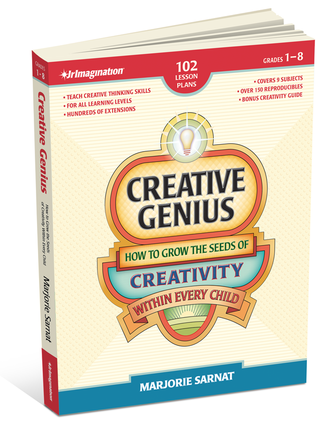Guide Your Kids Down the Creative Rapids
 Sunday, June 3, 2012 at 11:00PM |
Sunday, June 3, 2012 at 11:00PM |  Marjorie Sarnat
Marjorie Sarnat 
There’s a magical mind chemistry known as “Creative Flow,” where we feel in sync with our task, and fully focused on our goal. The term was coined by psychologist and author, Mihaly Csikszentmihalyi at the University of Chicago.
“Flow” describes a particular state of heightened consciousness. As Prof. Csikszentmihlyi describes it, creative people are at their peak when they experience a sense of “unified flowing from one moment to the next, in which we feel in control of our actions, and in which there is little distinction between self and environment; between stimulus and response; or between past, present, and future.”
Flowing On All Fours
We are most likely to get into flow when our environment has four essential factors. The principles of flow hold true for kids, as well. Provide these factors for your kids, and you may be amazed.
- Match Task To Skill Level The first and most important factor for creative flow requires that your child’s skills match the challenge of the task. A challenge that’s beyond his or her skills may cause frustration; a task that isn’t challenging enough results in boredom.
Know the skill levels of your kids and present a creative challenge that inspires them to stretch realistically. For example, if you ask individuals or a team to design a new board game around a jungle theme, make sure they have a sufficient knowledge base to inspire relevant ideas. They will also need reading, writing, and drawing skills, along with familiarity with board games. Access to supplies is important, too. - Clear Goal Flow occurs when the goal is clear in the mind of the creative person. Make sure your kids fully understand the goal. For example, “Design and make an original board game about the jungle.” Explain what you expect them to do, and offer some do’s and don’ts.
Since the nature of creative thought is divergent, remind them to keep their eyes on the ball as they develop ideas. Have them write the goal down in bold letters on a sheet of paper, and tack it up where they can see it as they work. - Feedback Flow occurs when one gets constant and immediate feedback about how close one is to achieving the goal. It’s important to keep the lines of communication open between the teacher/parent and kids so they can ask and be asked about their developing ideas-- but let them make their own decisions. Also encourage kids to provide respectful feedback for each other. Which game ideas are fun? Which tell about the jungle? What looks attractive? What could be improved?
- Environment for Focus Flow occurs when one is free to concentrate fully on the task. This includes being physically comfortable (such as good lighting, enough room to work, comfortable clothing), eliminating distractions (such as annoying sounds, out-of-control kids, off-topic discussions) and allowing a long enough time span for working. Three 15 minute work periods will not be as effective toward reaching creative flow as would an uninterrupted 45 minute time stretch.
Young learners who are given creative challenges with these four work conditions have the stage set to reach creative flow.
Visit The Great State Of Flow
Csikszentmihalyi indicates his research shows flow as the most essential ingredient in creativity. His test subjects have described flow as a sense of competence and control, a loss of self-consciousness, and deep absorption in the task to the extent that they lose track of time. Creative people, across all backgrounds and fields of endeavor, have reported having their most important insights and achievements while in the great state of “flow.”
It’s always a joy to see our kids working at a task, head down in concentration, or head up with enthusiasm. Keep in mind the ways to structure their environment to help them go with the flow and you’ll be the kind of guide they trust and want to take them on their creative adventures.
 Csikszentmihalyi,
Csikszentmihalyi,  creative flow,
creative flow,  creativity,
creativity,  kids,
kids,  students
students 


